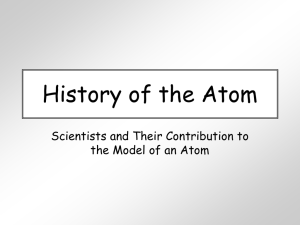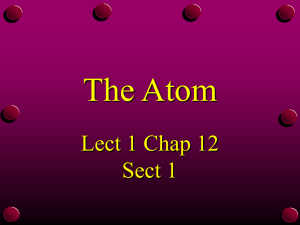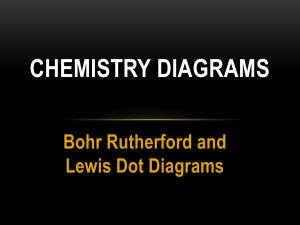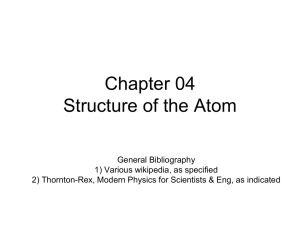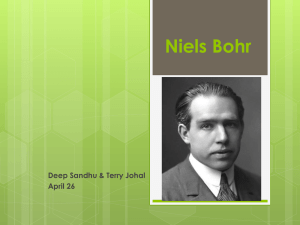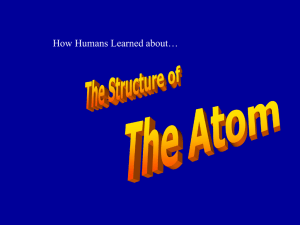CHAPTER 4: Structure of the Atom
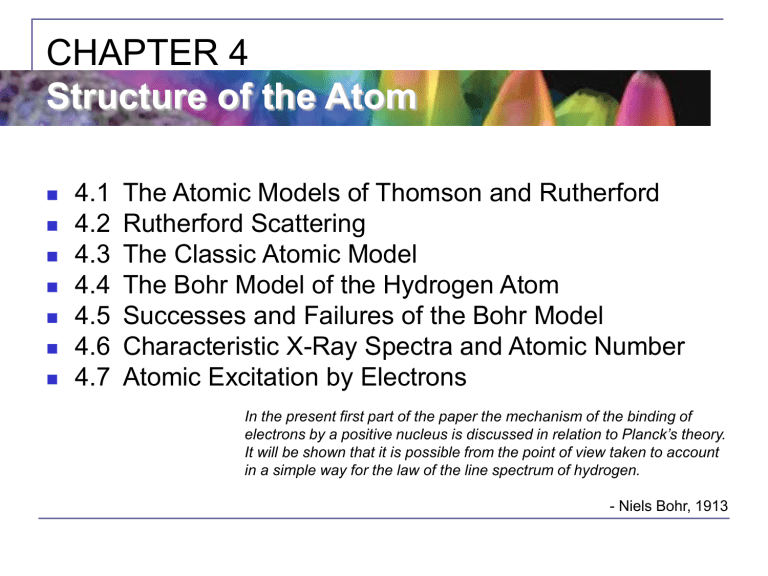
CHAPTER 4
Structure of the Atom
4.1 The Atomic Models of Thomson and Rutherford
4.2 Rutherford Scattering
4.3 The Classic Atomic Model
4.4 The Bohr Model of the Hydrogen Atom
4.5 Successes and Failures of the Bohr Model
4.6 Characteristic X-Ray Spectra and Atomic Number
4.7 Atomic Excitation by Electrons
In the present first part of the paper the mechanism of the binding of electrons by a positive nucleus is discussed in relation to Planck’s theory.
It will be shown that it is possible from the point of view taken to account in a simple way for the law of the line spectrum of hydrogen.
- Niels Bohr, 1913
Structure of the Atom
Pieces of evidence that scientists had in 1900 to indicate that the atom was not a fundamental unit:
1)
2)
3)
4)
There seemed to be too many kinds of atoms, each belonging to a distinct chemical element.
Atoms and electromagnetic phenomena were intimately related.
The problem of valence . Certain elements combine with some elements but not with others, a characteristic that hinted at an internal atomic structure.
The discoveries of radioactivity, of x rays, and of the electron.
Thomson’s Atomic Model
Thomson’s “plum-pudding” model of the atom had the positive charges spread uniformly throughout a sphere the size of the atom, with electrons embedded in the uniform background.
In Thomson’s view, when the atom was heated, the electrons could vibrate about their equilibrium positions, thus producing electromagnetic radiation.
Radius of an Atom:
.
The number of atoms in gold :
Assume the distance between atoms is
.
.
Experiments of Geiger and Marsden
Rutherford, Geiger, and Marsden conceived a new technique for investigating the structure of matter by scattering a particles from atoms.
Geiger showed that some a particles were scattered from thin gold-leaf targets at backward angles greater than 90 °.
Electrons can’t backscatter
a
particles.
Scattering from 1 electron:
The maximum scattering angle corresponding to the maximum momentum change.
Maximum momentum change of the α particle is or
Determine θ by letting Δ p max be perpendicular to the direction of motion.
Multiple Scattering from Electrons
If an α particle were scattered by many electrons and N electrons results in .
The number of atoms across the thin gold layer of 6 × 10 −7 m:
Assume the distance between atoms is and there are .
That gives .
Rutherford’s Atomic Model
even if the α particle scattered from all 79 electrons in each atom of gold.
The experimental results were not consistent with Thomson’s atomic model.
Rutherford proposed that an atom has a positively charged core
(nucleus) surrounded by the negative electrons.
The positive charge is concentrated in a nucleus with a radius much smaller than 10 -10 m
4.2: Rutherford Scattering
Scattering experiments help us study matter too small to be observed directly.
There is a relationship between the impact parameter b and the scattering angle θ .
When b is small, r gets small.
Coulomb force gets large.
θ can be large and the particle can be repelled backward.
Rutherford Scattering
Any particle inside the circle of area
πb
0
2 will be similarly scattered.
The cross section σ = πb 2 is related to the probability for a particle being scattered by 1 nucleus.
.
The number of scattering nuclei per unit area
The fraction of incident particles scattered is f = ntA s
/A
Rutherford Scattering Equation
In actual experiment a detector is positioned from θ to θ + d θ that corresponds to incident particles between b and b + db .
The number of particles scattered per unit area is
4.3: The Classical Atomic Model
Let’s consider atoms as a planetary model.
The force of attraction on the electron by the nucleus and Newton’s
2nd law give
where v is the tangential velocity of the electron.
The total energy is
The Classical Atomic Model
Consider an atom as a planetary system.
The Newton’s 2 nd Law force of attraction on the electron by the nucleus is:
F e
1
4
0 e
2
m v r
2 r
2 where v is the tangential velocity of the electron: v
4 e
0 mr
K
1
2 m v
2
1
2 e
2
4
0 r
The total energy is then:
This is negative, so the system is bound, which is good.
The Planetary Model is Doomed
From classical E&M theory, an accelerated electric charge radiates energy (electromagnetic radiation) which means total energy must decrease. Radius r must decrease!!
Electron crashes into the nucleus!?
Physics had reached a turning point in 1900 with Planck’s hypothesis of the quantum behavior of radiation.
The Bohr Model of the Hydrogen Atom
Bohr’s general assumptions:
1. Stationary states , in which orbiting electrons do not radiate energy, exist in atoms and have well-defined energies,
E n
. Transitions can occur between them, yielding light of energy:
E = E n
− E n
’
= h n
2. Classical laws of physics do not apply to transitions between stationary states, but they do apply elsewhere.
n = 2 n = 1 n = 3
3. The angular momentum of the n th n where n is called the Principal Quantum Number.
Angular momentum is quantized!
4.4: The Bohr Model of the Hydrogen Atom
Bohr’s general assumptions:
1)
2)
“Stationary states” (orbiting electrons do not radiate energy) exist in atoms.
E = E
1
− E
2
= hf
3) Classical laws of physics do not apply to transitions between stationary states.
4) The mean kinetic energy of the electron-nucleus system is
K = nhf orb
/2, where f orb is the frequency of rotation. This is equivalent to ask that the angular momentum L=nh/(2
)
Consequences of the Bohr Model
The angular momentum is:
L
m v r
n
So the velocity is:
But: v
e
4
v
n / mr
0 mr
So: n
2 2
2 2 m r
e
2
4
0 mr
Solving for r n
: n
2 r n a
0 where: a
0 a
0
4
0 me
2
2 a
0 is called the Bohr radius. It’s the diameter of the Hydrogen atom (in its lowestenergy, or “ground,” state).
Bohr Radius
The diameter of the hydrogen atom for stationary states is
Where the Bohr radius is given by
The smallest diameter of the hydrogen atom is
n = 1 gives its lowest energy state (called the “ground” state)
The Hydrogen Atom
The energies of the stationary states where E
0
= 13.6 eV.
Emission of light occurs when the atom is in an excited state and decays to a lower energy state ( n u h n
→ n ℓ
).
E u
E where n is the frequency of a photon.
1
n h n c hc
R
∞ is the Rydberg constant .
Transitions in the Hydrogen Atom
The atom will remain in the excited state for a short time before emitting a photon and returning to a lower stationary state. All hydrogen atoms exist in n = 1 (invisible).
Fine Structure Constant
The electron’s velocity in the Bohr model:
On the ground state, v
1
= 2.2 × 10 6 m/s ~ less than 1% of the speed of light.
The ratio of v
1 to c is the fine structure constant .
The Correspondence Principle
Classical electrodynamics
+ Bohr’s atomic model
Determine the properties of radiation
Need a principle to relate the new modern results with classical ones.
Bohr’s correspondence principle
In the limits where classical and quantum theories should agree, the quantum theory must reduce the classical result.
The Correspondence Principle
The frequency of the radiation emitted n classical frequency n orb is equal to the orbital of the electron around the nucleus.
n classical
n orb
2
n v /
2
r
This should agree with the frequency of the transition from n + 1 to n
(when n is very large): n
Bohr
For large n :
Substituting for E
0
: n
Bohr n
Bohr n classical
Characteristic X-Ray
Spectra and Atomic
Number
Shells have letter names:
K shell for n = 1
L shell for n = 2
The atom is most stable in its ground state.
An electron from higher shells will fill the inner-shell vacancy at lower energy.
When it occurs in a heavy atom, the radiation emitted is an X-ray .
It has the energy E ( X-ray ) = E u
− E ℓ
.
Moseley’s Empirical Results
The X ray is produced from n = 2 to n = 1 transition.
In general, the K series of X-ray wavelengths are
Moseley’s research clarified the importance of the electron shells for all the elements, not just for hydrogen.
4.7: Atomic Excitation by Electrons
Franck and Hertz studied the phenomenon of ionization.
Accelerating voltage is below 5 V. electrons did not lose energy.
Accelerating voltage is above 5 V.
sudden drop in the current.
Atomic Excitation by Electrons
Ground state has E
0 to be zero.
First excited state has E
1
.
The energy difference E
1
− 0 = E
1 is the excitation energy .
Hg has an excitation energy of
4.88 eV in the first excited state
No energy can be transferred to
Hg below 4.88 eV because not enough energy is available to excite an electron to the next energy level
Above 4.88 eV, the current drops because scattered electrons no longer reach the collector until the accelerating voltage reaches 9.8 eV and so on.
More details on the Bohr Model
The electron and hydrogen nucleus actually revolved about their mutual center of mass.
The electron mass is replaced by its reduced mass .
The Rydberg constant for infinite nuclear mass is replaced by R .
Limitations of the Bohr Model
The Bohr model was a great step of the new quantum theory, but it had its limitations.
1)
2)
3)
Works only to single-electron atoms.
Could not account for the intensities or the fine structure of the spectral lines.
Could not explain the binding of atoms into molecules.

